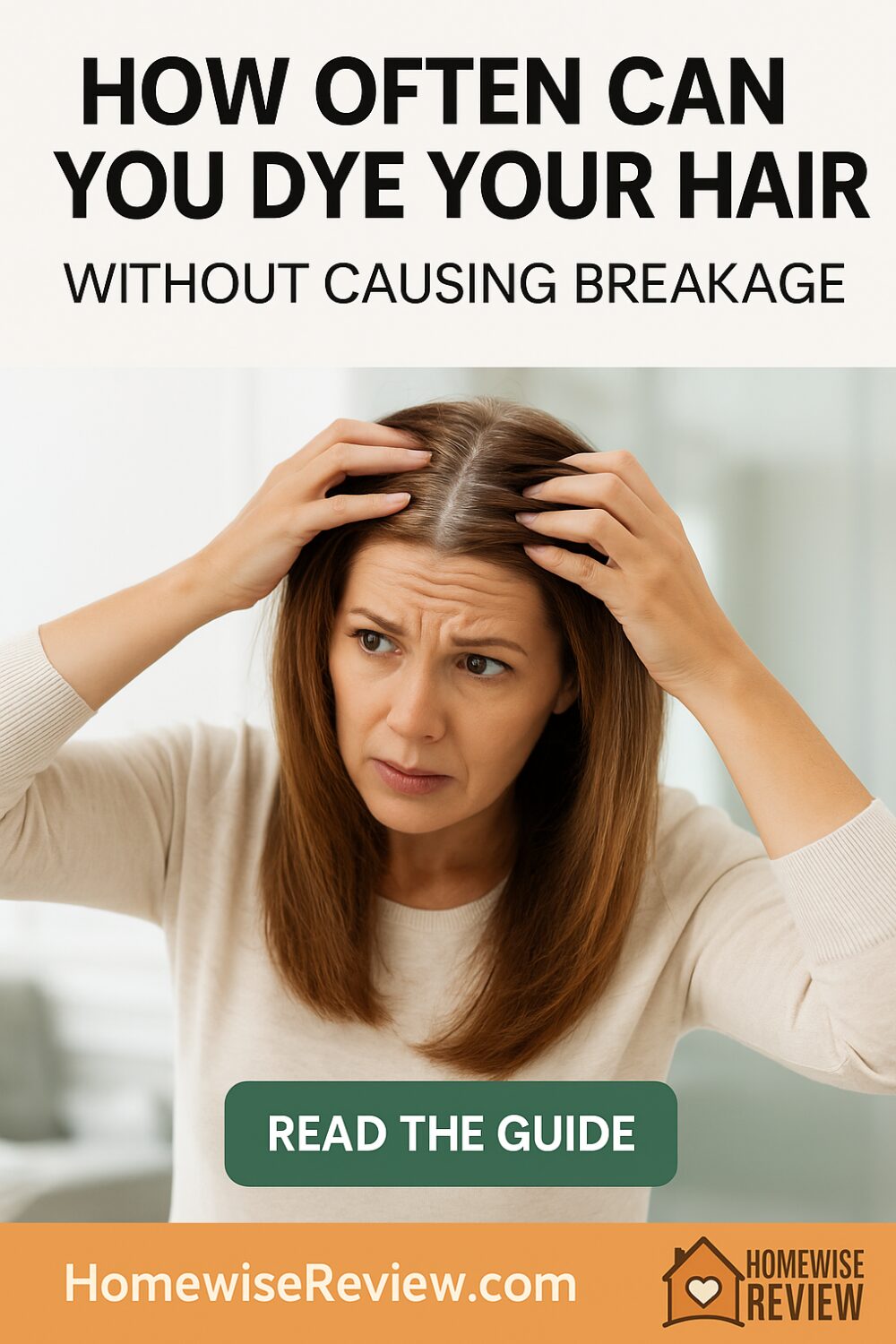
Coloring at home can be totally fine if you respect timing. Most damage happens when people panic about roots, try to fix patchy color too fast, or keep bleaching the same hair over and over. This guide walks you through how long you should wait between color sessions so you keep the look you want without frying the cuticle.
This fits into the same at-home color plan we cover in Best At-Home Hair Dye. That hub is your home base for bleach, box dyes, toners, stain removal, and aftercare.
Why spacing between dye jobs matters
Any time you color, you are stressing the outer layer of the strand. Permanent dye lifts the cuticle and changes the inside of the hair so the pigments grab on. Bleach goes even harder. It removes natural pigment and weakens the bonds that keep the strand strong, smooth, and flexible. Even if your hair still feels soft right after rinsing, it is a little more fragile each time.
If you color again too soon, three things usually happen:
- Ends start to go dull, frizzy, and stretchy when wet. That stretchy, gummy feeling means the protein structure is getting chewed up.
- You get “banding,” which is when parts of your hair grab color differently because some sections have been dyed four times and some only one. That is how people end up with stripes or random warm patches when they try to go blonde.
- Breakage at the hairline and crown shows up first. That is the hair that deals with the most heat and brushing already, so it snaps fastest.
Letting hair rest between sessions gives the cuticle time to re-seal a bit, lets you deep condition and rebuild softness, and stops you from stacking harsh chemicals on the same exact strand over and over. So the real question is not “how fast can I redo this,” it is “how do I keep this color while touching the least amount of hair.”
This timing logic is built into all our color guides, like How to Bleach Hair at Home and How to Lighten Hair Without Bleach. Those walk you through doing sections in a controlled way instead of slapping product everywhere.
Safe timelines by dye type
Different dyes hit the hair differently. You do not treat temporary purple the same way you treat permanent brown, and you definitely do not treat either of those like bleach.
Here is how long most people should wait before doing an all-over color again.
Permanent hair dye (full-head color change)
Permanent dye is the classic box dye that says “lasts up to 8 weeks.” It works by opening the cuticle and depositing pigment inside the hair. Because it is pretty aggressive, you generally do not want to re-dye your full head sooner than every 6 to 8 weeks.
What you can do sooner is root-only application. That means you apply permanent dye only to the new growth near your scalp, not through your mids and ends. We will talk about that in detail later.
If you keep pulling permanent color all the way through to the ends every 2 or 3 weeks, you will get dryness, snapping around the face, and that dull, stained look on the bottom half of the hair. If you are choosing a long-wear formula, pick one that matches where you actually want to sit for a while. Our Best Permanent Hair Dye roundup focuses on shades that fade in a softer, more wearable way instead of going orange or flat.
Demi-permanent and semi-permanent dye
Demi and semi live on top of the cuticle more than inside it. They boost tone, add richness, or refresh a faded shade. They usually do not contain the same level of developer that permanent dye does. Because of that, you can usually refresh demi or semi color a little more often, around every 3 to 4 weeks, as long as your hair still feels healthy and not gummy.
This is how a lot of people keep reds, coppers, chocolate browns, and glossy blacks looking fresh without doing full permanent color each time. If you are just refreshing tone on hair that already has color, you are usually safe closer to the 3-week mark. If you are doing darker all-over deposits on hair that was bleached, stretch it longer. That bleached base is already fragile, so treat it like permanent dye timing.
If you love vivid fashion shades, like purple or blue, you already know they fade fast. Our Best Purple Hair Dyes picks are the kind of formulas people re-glaze often. Just remember, fast fading does not automatically mean you can reapply twice a week. You still have to watch texture.
Temporary color and wash-out color
Temporary sprays, colored conditioners, tinted gels, and those “one night only” tints sit on top of the hair and usually rinse in a shampoo or two. These are the only products you can realistically use back to back in the same week without a real break, because they are basically stain plus styling product.
The catch is staining. Darker temporary pigments, like black and dark brown spray, can still grab onto light or bleached hair and hang around. We cover this in Best Temporary Hair Dye, including which tints can cling to blonde and leave a shadow. So yes, you can use them again tomorrow. Just be real about buildup on the cuticle and the risk of a leftover tint if your base is very light.
Bleach and high-lift lightening
Bleach is the strict one. Bleach is not something you do on the same length of hair every 2 weeks. For a full-head bleach or a dramatic lift, most people should wait at least 6 to 8 weeks before doing a second round on the same areas. Even then, the hair might say “nope.”
Root touch-ups with bleach are different. Roots that just grew in are virgin hair. You can usually do a careful root bleach after 4 to 6 weeks of regrowth, as long as you only apply bleach to the new hair and you avoid overlapping onto previously bleached areas. If you overlap, that is where breakage happens first.
This is why we push bond care and moisture repair after any lift. Best Hair Masks for Bleached Hair is built around that exact recovery window.
Signs you need to wait longer before coloring again
The calendar is helpful. Your actual hair is more honest.
You should pause and wait longer if you notice any of these:
Your hair feels stretchy and gummy when wet
Healthy hair will stretch a little under tension, then spring back. Over-processed hair stretches like overcooked pasta and does not bounce back. That means the internal structure has been weakened. Coloring again at that point will usually snap it.
Your ends look see-through
If the last two inches of your hair look thin, ragged, or almost translucent, that is early breakage. Re-dyeing those ends will make them fray and pop off completely, especially with bleach or permanent dye.
Your hairline is snapping
Look at the baby hairs near your temples. If they suddenly look shorter and rougher, that is a warning sign. Most people blame ponytails, but repeated dye on delicate edges will do this just as fast.
Your scalp is irritated or flaky
If you had stinging, itching, or flaking after your last dye job, stop and fix that first. You do not stack more chemicals onto an already angry scalp. A gentle clean up routine and barrier care matters here. We talk about stain cleanup around the face in How to Get Hair Dye Off Skin, which also covers how to protect that area next time.
Color looks uneven or patchy already
Patchiness means parts of your hair absorbed product faster than others. If you rush in again to “fix” it without letting the hair rest, you risk turning patchy into fried. At that point, controlled toning or targeted color correction is safer than blasting the whole head a second time.
Bottom line. If your hair or scalp is telling you to slow down, slow down. There is no box dye on earth that is worth a chemical haircut.
How to protect your hair between color sessions
Giving yourself 4, 6, or 8 weeks between color jobs is only helpful if you baby the hair during that gap. Otherwise you come back in just as dry and stressed.
Here is what helps most.
Use repair masks on a schedule, not only when it feels crispy
Bleach and permanent dye lift the cuticle. A bond rebuilding or protein-support mask helps refill some of that lost structure. Moisture masks help smooth frizz and keep the cuticle from roughing up even more. Rotating the two is smarter than just grabbing the thickest mask you own. We break down moisture vs bond care in Best Hair Masks for Bleached Hair so you are not guessing.
Limit direct heat on fragile areas
If you have recently bleached or permanently dyed, turn down the flat iron and skip daily curling on the money pieces around your face. Freshly processed hair plus 400 degree heat is a split waiting to happen.
Sleep on something that does not saw at your hair
Even a simple soft pillowcase and a loose braid at night can cut down on friction and snapping at the ends, especially if you are in that 6 to 8 week wait between permanent color sessions.
Do not keep re-shampooing to chase shine
Over-washing strips the little bit of protective oil your scalp is still making. That oil helps the hair survive until your next dye day. If you are using heavily pigmented temporary color (like purple or copper refreshers), use a gentle wash and rinse well so you are not layering product on product and choking the cuticle.
Protect skin and edges before the next round
Before you color again, use a light barrier cream around your hairline and ears. That keeps stain off skin, which we explain step by step in How to Get Hair Dye Off Skin. It also lowers irritation, which helps you last longer between full recolors.
When it is OK to touch up roots sooner
Roots are an exception.
Most people can safely refresh roots earlier than they can redo an all-over color, because the roots are new growth. The rule is: only touch the new growth, and only with the product type you originally used there.
For permanent brunette, black, or dark brown shades
You can usually do a root touch-up around the 4 to 5 week mark if the demarcation line is bugging you. You keep the dye on the uncolored roots, then lightly feather it into the line where the old color starts. You do not pull it through to the ends again.
For blonde or lightened shades that used bleach
You can usually bleach roots every 4 to 6 weeks. Any longer than that and you get a visible band where the heat from your scalp can no longer help the lift. The key is precision. You apply bleach to the new growth only, and you avoid overlapping onto hair that has already been lifted. That is exactly what we walk through in How to Bleach Hair at Home, including sectioning and timing.
For fantasy or fashion shades
Bright purples, blues, pinks, and coppers fade fast. You can refresh those tones more often because most of those formulas are semi or demi. Just remember that if your base is bleached, the bleached hair itself still needs that 6 to 8 week healing window before you bleach it again. Re-toning a faded purple is not the same thing as bleaching it again to go even lighter.
If you are not sure, default to root-only touch ups and leave the rest of your hair alone until you hit the 6 to 8 week range. That is the safest rhythm for most people, especially if your hair is already chemically processed.
Final Thoughts
There is no single “safe number” that works for every head of hair. The right gap depends on what you used, how light you went, and how your hair handled it. In general, full-head permanent dye is more of an every 6 to 8 weeks thing, bleach on the same length of hair is even slower, and root touch-ups are allowed sooner if you are careful and precise.
If you listen to your actual strands and scalp, and you treat color like maintenance instead of panic repair, you can color at home without wrecking your hairline or snapping off your ends. That is the whole goal behind our Best At-Home Hair Dye hub. You want pretty color that still brushes, styles, and grows.
See also
If you are thinking about bleaching or going lighter fast, read How to Bleach Hair at Home before you mix anything. It shows sectioning, timing, and why you only lift virgin roots instead of dragging bleach through already processed mids. If you want a softer lift or you are scared of bleach, How to Lighten Hair Without Bleach explains high-lift color, sun and heat tricks, and what is realistic if you are starting brunette.
If you are choosing a box dye and you want staying power without a straw feeling, Best Permanent Hair Dye and Best Dark Brown Hair Dyes walk through shades that hold up without turning flat or orange. If you are already light and worried about brass or fading, especially if you play with vivid tones, Best Purple Hair Dyes covers low-commitment color that you can refresh more often with less stress. All of these are part of the same Best At-Home Hair Dye cluster, so they connect on purpose.
FAQs
1. Is it safe to dye my hair again after two weeks if I hate the color?
Usually no for permanent dye or bleach. Two weeks is almost always too soon for another full chemical process. You are better off toning, using a color-depositing conditioner to shift warmth, or living with it for a few more weeks instead of risking breakage. If it is a temporary tint, that is different. You can wash that out and try a new temporary shade sooner.
2. How long should I wait between bleaching sessions if I want to go from dark brown to blonde?
Most people should space real bleach lifts by 6 to 8 weeks on the same hair. Trying to jump from dark brown to pale blonde in one weekend is how you get rubbery ends and snapping around the face. Slow lift plus bond care is safer and usually looks better.
3. Can I keep using semi-permanent color every few weeks without damage?
You usually can, as long as your hair still feels strong, not mushy, and your scalp is calm. Semi and demi shades mostly sit on top and boost tone. Just be careful if your base hair was bleached, because the base is still fragile even if the refresh itself is gentle.
4. Why are my ends so frizzy and rough after a couple rounds of dye?
That is cuticle damage. Color lifted the outer layer and now it will not seal flat again on its own. A bond repair or strengthening mask can help, followed by deep moisture. Our Best Hair Masks for Bleached Hair guide talks about when to use bond repair and when to use hydration so you do not overload with heavy product.
5. My roots look obvious at four weeks. Is it OK to just do the roots now?
Yes. Root-only touch ups are normal. You apply dye to fresh regrowth, not through the whole length again. Same with bleach. You can lighten new growth if you are careful and keep product off hair that was already lifted. Our How to Bleach Hair at Home guide shows how to keep bleach exactly where it should go so you do not melt your mids.




